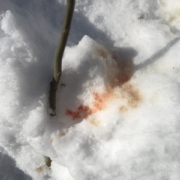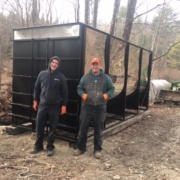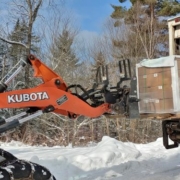In Sync
In our Nature Notes section in January, Volume I, we included a picture of blood in coyote urine that was taken last January 23. Here’s a picture we took this year, on January 25, of the same thing. The blood is an indication that the endometrial lining in the female’s uterus is developing, and she’ll soon go into heat.
It’s not surprising that a coyote’s reproductive cycle, which takes its cue from the amount of sunlight in the day, is so regular year in and year out. After all, there’s a sweet spot when puppies should be conceived and then subsequently born. If they’re born too early, they risk dying from the cold right away. If they’re born too late, they risk going into next winter undersized and dying then. Thousands of years of evolution have helped determine the sweet spot, though it’ll be interesting to see how the changing climate affects things going forward.



